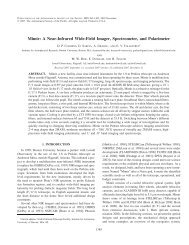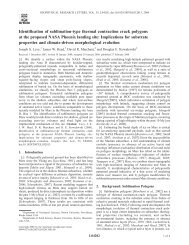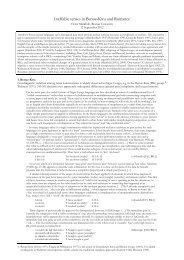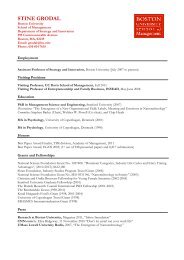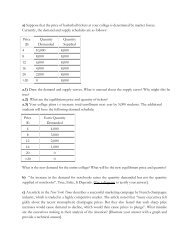Intertemporal Substitution and Recursive Smooth Ambiguity ...
Intertemporal Substitution and Recursive Smooth Ambiguity ...
Intertemporal Substitution and Recursive Smooth Ambiguity ...
You also want an ePaper? Increase the reach of your titles
YUMPU automatically turns print PDFs into web optimized ePapers that Google loves.
We can similarly define ambiguity loving <strong>and</strong> ambiguity neutrality. Definition 9 says thatif a first-stage mixture of acts is preferred to their second-stage mixture, then the decisionmaker is ambiguity averse. The intuition for this definition is that hedging across ambiguousstates is valuable compared to r<strong>and</strong>omization of acts before the realization of the states. Itis related to Gilboa <strong>and</strong> Schmeidler’s (1989) definition of ambiguity aversion, which statesthat hedging across states for two indifferent acts is valuable to an ambiguity averse decisionmaker. 17 When ≽ s t is replaced with ∼ s t in (20), then it becomes the dynamic counterpartof Seo’s Reversal of Order axiom. Thus, ambiguity attitude is associated with the violationof the Reversal of Order axiom.An example taken from Seo (2009) illustrates Definition 9. Restrict attention to a staticsetting. Consider an Ellsberg urn which contains 100 black or white balls, but the exactcomposition is unknown. The state of the world is the color of the ball. Let f be the actthat gives $100 if the chosen ball is black <strong>and</strong> nothing otherwise. Let g be the act thatgives $100 if the chosen ball is white <strong>and</strong> nothing otherwise. Let p be a lottery with 50%of winning $100. Experimental evidence reveals that most people are indifferent between f<strong>and</strong> g, but prefer p to f <strong>and</strong> p to g. The first-stage mixture 1f + 1 g is still an ambiguous2 2act. But the second-stage mixture 1f ⊕ 1 g gives an identical lottery p no matter whether the2 2chosen ball is black or white. Thus, it is intuitive that an ambiguity averse decision makerprefers 1 2 f ⊕ 1 2 g to 1 2 f + 1 2 g.As Seo (2009) <strong>and</strong> Segal (1987, 1990) point out, ambiguity attitude is associated withthe violation of the Reduction of Compound Lotteries. 18We now characterize this relationship.In his atemporal model, Seo (2009) shows that Reduction of Compound Lotteries<strong>and</strong> Reversal of Order are equivalent under Dominance. Adapting his argument to our dynamictwo-stage compound lottery acts framework, we show below that ambiguity aversionis identical to risk aversion in the first stage.Proposition 5 Suppose {≽ s t} satisfies Axioms B1-B7. Then {≽ s t} exhibits ambiguity aversionif <strong>and</strong> only if {≽ s t} exhibits risk aversion in the first stage.An immediate implication of this proposition is that ambiguity aversion is equivalent toconcavity of v ◦u −1 . In addition, the decision maker is ambiguity neutral if <strong>and</strong> only if v ◦u −117 Given Axiom B4 (First-Stage Independence), our definition implies the following Gilboa-Schmeidler’sdefinition of ambiguity aversion: (c, δ[h +1 ]) ∼ s t (c, δ[h ′ +1]) =⇒ (c, δ[λh +1 ⊕ (1 − λ)h ′ +1]) ≽ s t (c, δ[h +1 ]), forall s t , c ∈ C, h +1 , h ′ +1 ∈ H +1 , <strong>and</strong> λ ∈ [0, 1],18 Halevy (2007) finds experimental evidence to support this view. This view is controversial becausenonreduction of compound lotteries is arguably a ‘mistake.’25



